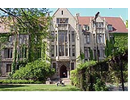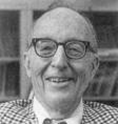 The website is in construction. New files will be uploaded as soon as they are available.
The website is in construction. New files will be uploaded as soon as they are available.SAUNDERS MAC LANE
Norwich, Connecticut 1909 - San Francisco, California 2005

- Brief scientific biography
- Contributions to Education
- Relevant bibliography
- Publications on the teaching of mathematics
Brief scientific biography
Saunders Mac Lane was born in Norwich, Connecticut, on 4 August 1909.

Leet Oliver Memorial Hall,
Yale University
Yale University
Once back in the United States,

Eckert Hall,University of Chicago

Mac Lane was one of only

From 1952 to 1954, Mac Lane was a vice-president of the International Commission on Mathematical Instruction. He served on the Executive Committee of the International Mathematical Union from 1955 to 1958.
Contributions to Education
While president of
We must contrive ever anew to expose our students — be they general students or specialized students — to the beauty and excitement and relevance of mathematical ideas. We must set forth the extraordinary way in which mathematics, springing from the soil of basic human experience with numbers and data and space and motion, builds up a far-flung architectural structure composed of theorems which reveal insights into the reasons behind appearances and of concepts which relate totally disparate concrete ideas. (MAC LANE, 1954, p. 152)He proceeded to describe in some detail the curriculum in mathematics at the University of Chicago as an illustration of the integrated structure he sought for college mathematics courses.
Writing in the Bulletin of the National Association of Secondary-School Principals in May 1954, Mac Lane argued that "the lively modern development of mathematics has had no impact on the content or on the presentation of secondary-school mathematics" (p. 66). He noted how the growing applications of mathematics in science and technology together with the severe shortage of new mathematical talent demanded both an improved school mathematics curriculum but also a new generation of teachers trained in modern mathematics. He proceeded to sketch some of the ideas of modern mathematics that should be dealt with in secondary school, concluding with a call for change:
The mathematical subjects now taught [in secondary school] need drastic overhauling. It no longer suffices to continue to teach the old ideas; rather, one must start afresh to determine which ideas should be taught and in what perspective. In this way, school mathematics could become fully relevant to the modern world. (p. 70)Mac Lane (1994) offered intuition, trial, error, speculation, conjecture, proof as the sequence in which we come to understand mathematics. His point was that although mathematicians may do mathematics in many different ways, the path to understanding it always ends in rigorous proof. In his own teaching and in his writings on education, he advocated careful attention to abstraction and proof treated carefully and in recognition of the soil from which mathematics springs.
Relevant bibliography
G. BIRKHOFF, S. MAC LANE 1941, A survey of modern algebra, New York: Macmillan
S. MAC LANE, G. BIRKHOFF 1967, Algebra, New York: Macmillan
S. MAC LANE 1971, Categories for the working mathematician, Berlin: Springer-Verlag
S. MAC LANE 1986, Mathematics: Form and function, Berlin: Springer-Verlag
S. MAC LANE 1994, Response to "Theoretical mathematics: Toward a cultural synthesis of mathematics and theoretical physics",by A. Jaffe and F. Quinn , Bulletin of the American Mathematical Society (New Series), 30, 190-193
S. MAC LANE 2005, A mathematical autobiography, Wellesley, MA: AK Peters
G. ALEXANDERSON, S. MAC LANE 1989, A conversation with Saunders Mac Lane, College Mathematics Journal, 20, 2-25
R.P. Jr. BOAS 1975, Award for Distinguished Service to Professor Saunders Mac Lane, American Mathematical Monthly, 82, 107-108
J.J. O'CONNOR, E.F. ROBERTSON 1997, Saunders Mac Lane, retrieved from the MacTutor History of Mathematics Archive web site:
http://www-history.mcs.st-andrews.ac.uk/Biographies/MacLane.html
I. KAPLANSKY (edited by) 1979, Saunders Mac Lane: Selected papers, New York & Berlin: Springer-Verlag
C. MC LARTY 2005, Saunders Mac Lane (1909-2005): His mathematical life and philosophical works, Philosophia Mathematica, 13(3), 237-251
J. PEARCE 2005, Saunders Mac Lane, 95, pioneer of algebra's category theory, The New York Times, A21
Publications on the teaching of mathematics
S. MAC LANE 1954, Of course and courses, American Mathematical Monthly, 61, 151-157
S. MAC LANE 1954 (May), The impact of modern mathematics on secondary schools, Bulletin of the National Association of Secondary-School Principals, 38, 66-70, reprinted in 1956 in the Mathematics Teacher, 49, 66-69
S. MAC LANE 1957, Algebra, in F.L. Wren (edited by), Insights into modern mathematics (23rd Yearbook of the National Council of Teachers of Mathematics, Washington, DC: The Council, pp. 100-144)
S. MAC LANE 1989, The education of Ph.D.s in mathematics, in P. Duren (edited by), A century of mathematics in America, Providence, RI: American Mathematical Society, Part 3, 517-523
Author
Jeremy Kilpatrick
University of Georgia
jkilpat@uga.edu
